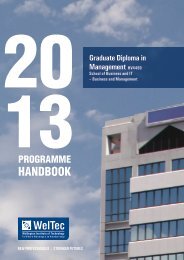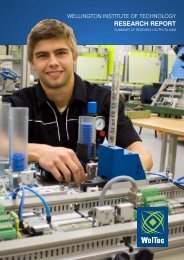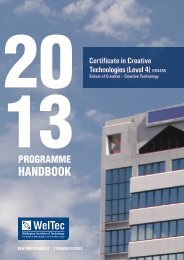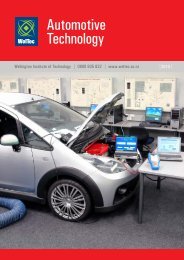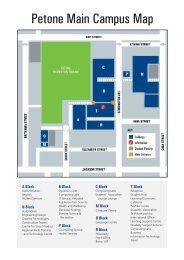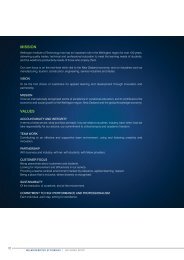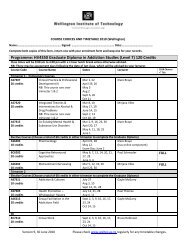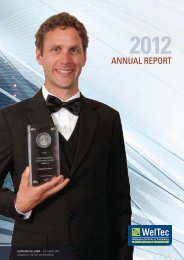1 programme handbook - Wellington Institute of Technology
1 programme handbook - Wellington Institute of Technology
1 programme handbook - Wellington Institute of Technology
- No tags were found...
You also want an ePaper? Increase the reach of your titles
YUMPU automatically turns print PDFs into web optimized ePapers that Google loves.
ACADEMIC CALENDAR - 2013The up-to-date, day-to-day and week-by-week timetables are located at:http://timetable.weltec.ac.nz/.<strong>Wellington</strong> <strong>Institute</strong> <strong>of</strong> <strong>Technology</strong> - 2013 HV4177 Programme Handbook February 2013Overview and Programme Specific Information Page 8
• demonstrate safe welding practices under supervision• use engineering hand tools and portable hand held engineering power tools• service electrical appliances• construct simple electronic products• explain introductory electric principlesGraduates will have acquired a range <strong>of</strong> literacy and numeracy skills equipping them foremployment, or for continuing study.CAREERSMove into apprenticeshipsElectrical retail and wholesale careersSTAIRCASINGSuccessful graduates may:• Move onto a higher-level theoretically based and/or vocational/technical <strong>programme</strong>s.These include:• National Certificate in Electrical Engineering (Level 4), taken in conjunction with anapprenticeship;• National Diploma in Electrical Engineering• Move into the labour marketPROGRESS THROUGH THE PROGRAMMEtudents will normally complete the <strong>programme</strong> over two trimesters.GRADUATION CRITERIAIn order to graduate you must demonstrate competence in all <strong>of</strong> the components <strong>of</strong> the<strong>programme</strong>.Course Course Title. Level CreditsNumberEE2100 Electrical Safety and Testing 2 15EE2101 Electrical 1 2 15EE2107 Communications and Computing 2 15EE2105 Electrical Calculations 2 15EE2106 Trade Skills 2 15EE2103 Electrical 2 2 15EE3106 Electrical Appliance Servicing 3 15EE2104 Electronics 2 15LEARNING AND TEACHINGThis <strong>programme</strong> incorporates the following face to face learning and teaching deliverymodes:<strong>Wellington</strong> <strong>Institute</strong> <strong>of</strong> <strong>Technology</strong> - 2013 HV4177 Programme Handbook February 2013Overview and Programme Specific Information Page 10
• Class room sessions to introduce students to the theoretical requirements <strong>of</strong> the<strong>programme</strong>;• Workshop sessions to provide students with an opportunity to practice the practicalrequirements <strong>of</strong> the <strong>programme</strong>;• Laboratory sessions to allow students to strengthen their understanding <strong>of</strong> specific aspects<strong>of</strong> the <strong>programme</strong> through experimental work;• Computer simulations to reinforce specific aspects <strong>of</strong> the <strong>programme</strong>;• Assignments and reports to allow students to demonstrate an in depth knowledge <strong>of</strong>specific aspects <strong>of</strong> the <strong>programme</strong>;• Field visits to show students industry applications relevant to the Electrotechnologyindustry;Group activities that will allow students to benefit from the knowledge <strong>of</strong> colleagues and topractice working in teams.Electrical Appliance Serviceperson: 2.7 Electrical Appliance Serviceperson This is a form <strong>of</strong>registration with the Electrical Workers Registration Board (EWRB). There are basicallythree requirementsPractical assessment: This is done in the practical workshop usually in the third term. Allskills must be completed.Exam: This is an external exam set and marked by the EWRB.Practical experience: This can only be achieved in industry and is not done as part <strong>of</strong> thecourse. 1000hrs minimumASSESSMENT PROCEDURESYou need to become familiar with the assessment procedures for your courses and thisProgramme. Overall Programme procedures are given below. There may also be coursespecific assessment procedures and requirements noted in your Course Outlines.Please note that all activities that contribute towards your final course grades, and thereforeyour qualification completion, are known as assessments (summative assessments to beprecise). There are many different types <strong>of</strong> assessment activities your tutors use in yourcourses.The WelTec Academic Regulations section 7 require that you:make yourself available to undertake all summative assessment items at the timeand place stipulated by the teaching staff responsible for the courseact with integrity (honesty) during assessments. You are expected to:o Submit material that is your own original worko Collaborate only as permittedo Acknowledge contributions from other sources by using APA reference format(failure to do this correctly may be regarded as plagiarism)o Keep written and electronic work secure to prevent others from accessing andcopying worko Understand the definition <strong>of</strong> academic dishonesty and the consequences <strong>of</strong>breaching the regulations (see Academic Regulations S12 Dishonest Practice).WelTec conducts assessments within rules set out in the following regulations and policies: The Academic Regulations 2013o Examination Ruleso Aegrotat regulationso Gradeso Resultso Challenging Assessment Decisionso Dishonest Practice in Assessment<strong>Wellington</strong> <strong>Institute</strong> <strong>of</strong> <strong>Technology</strong> - 2013 HV4177 Programme Handbook February 2013Overview and Programme Specific Information Page 11
o AppealsPolicy 3.05 Assessment Policyo Definitionso Guidelines for assessment practicePolicy 3.07 Programme Moderation Policyo Quality assurance processes before using the assessment activityo Quality assurance processes after marking to verify marker’s consistencyYou may ask your tutors at any time about the quality-assured status <strong>of</strong> the assessmentactivities you are asked to complete.Assessment RationaleThe courses in this <strong>programme</strong> are assessed using competency-based methods.Assessment SchedulePlease refer to your Course Outline for the Assessment Schedule for each <strong>of</strong> your Courses.The Schedule will detail the assessment type (test, assignment, presentation, etc), the topicbeing assessed, due dates, and if appropriate the weighting. Any other conditions will alsobe noted as they apply to the assessments for that course.Practical AssessmentStudents will complete a range <strong>of</strong> practical projects each <strong>of</strong> which may cover severalperformance criteria from several unit standards; these projects will be recorded and thenmarked <strong>of</strong>f against the relevant unit standard assessment plan.Theory AssessmentTheory unit standards require you to demonstrate knowledge. You must• Study theory notes and all associated references carefully.• Bring all necessary equipment and resources to class. Those people without calculators,etc will be required to leave asAssessment Cover SheetsA Student Assessment Cover Sheet must be attached to all assessments handed/posted in.If you’re on campus you can find this form on the Student Intranet:1. Click on Forms and Documents > Assessment Forms2. Click on Student Assignment Cover Sheet – ASF0073. Print <strong>of</strong>f the form.If you are not on campus you can access them on the WelTec website:a. Go to the WelTec website: www.weltec.ac.nz/PH/b. Use the CITRIX link to login to WelTec's intranet (see the A-Z for details)c. Use instructions 1-3 above to print the cover sheet.Submitting Assessment And Assignment WorkIt is essential that you meet the assessment submission deadlines notified in your CourseOutlines' assessment schedules - unless you have pre-arranged for a late submission withyour tutor. Please refer to your course outlines for any penalties for late submission <strong>of</strong>assessments.Some assessments may have time-related criteria attached to them. Your course outline willnotify you <strong>of</strong> these particular assessments, and the reasons for the time criteria. Lateness,absence or early departure from these assessments may carry specific penalties.<strong>Wellington</strong> <strong>Institute</strong> <strong>of</strong> <strong>Technology</strong> - 2013 HV4177 Programme Handbook February 2013Overview and Programme Specific Information Page 12
Arranging for Late Submission Of AssessmentsIn case <strong>of</strong> illness, injury or exceptional circumstances you may request to make asubmission after the assessment due date by submitting a Request for Late SubmissionForm prior to the due date. On receiving your Request, your tutor may negotiate a newsubmission date/time. Where work has been handed in late without approval, lateassessment submission provisions will apply.Applying For An Extension Beyond The Course End DateIf you are prevented by illness, injury or exceptional circumstances from completing anassessment by the course end date, you may apply to the Associate Head <strong>of</strong> School for anextension to complete the assessment.The application is to be made in writing as soon as possible and not later than 48 hoursbefore the assessment due time and date. The application is made on the WelTec CourseExtension Form available from the Student Information Centre and the WelTec website.Where there are valid reasons, the Associate Head <strong>of</strong> School may grant an extension for aperiod <strong>of</strong> no more than three weeks after the course end date. A longer than three weeks’extension may be recommended by the Associate Head <strong>of</strong> School to the Board <strong>of</strong> Studies'Achievement Sub-Committee for approval, where there are extenuating circumstances thatjustify a longer extension.Penalty for Unarranged Late SubmissionThere will be no late submissions without an agreed arrangement.Absence From Supervised AssessmentsArriving at timetabled Assessments more than 30 minutes late may result in your nonadmittance,causing you to forfeit a submission attempt.Students who fail to attend a scheduled assessment without reasonable excuse ornotification will be marked absent and will be deemed to have had the opportunity to sit anassessment.Students unable to attend a scheduled assessment due to sickness or other valid reasonsmay complete the assessment on the first available re-sit date.Reassessment Of AssessmentsStudents who do not meet the expected level <strong>of</strong> competence at the first assessment will be<strong>of</strong>fered one reassessment. Students will complete a range <strong>of</strong> practical projects each <strong>of</strong> whichmay cover several performance criteria from several unit standards; these projects will berecorded and then marked <strong>of</strong>f against the relevant unit standard assessment plan.However, one further opportunity may be <strong>of</strong>fered at the discretion <strong>of</strong> the tutor in charge <strong>of</strong>the course or assessment. (Note a fee may apply.) The discretionary privilege will begranted where the student has undertaken remedial work needed to achieve competenceand in the judgement <strong>of</strong> the tutor has a good chance <strong>of</strong> success in that assessment. Anyfurther requests for reassessment must be submitted in writing to the Asssociate Head <strong>of</strong>School for approval.In the event that a reassessment is declined by the tutor in charge <strong>of</strong> the course orassessment, the student may apply for a review <strong>of</strong> the decision by the Associate Head <strong>of</strong>School.Assessment Results NotificationCourse assessment and final grades are reported using the Grade Key 1 method. GradeKeys are explained in Appendix 2 <strong>of</strong> the Academic Regulations.Once your tutor has marked your assessments you will be notified <strong>of</strong> your result.<strong>Wellington</strong> <strong>Institute</strong> <strong>of</strong> <strong>Technology</strong> - 2013 HV4177 Programme Handbook February 2013Overview and Programme Specific Information Page 13
• If the assessment is in the form <strong>of</strong> a practical in-class demonstration/observation, you arelikely to get your results immediately or shortly after the assessment activity has concluded.• If the assessment is a supervised test you are able to review your work, but theassessment is collected and retained by WelTec.• If you hand in an assignment it is returned to you along with feedback to explain thereason(s) for the assessment result.• If you sit a final exam you are able to view your result online at the student results portal:https://results.weltec.ac.nz within 15 working days.Results for each assessment are available within 15 working days on WelTec's StudentResults portal at: https://results.weltec.ac.nz.Use your normal WelTec login and password to access a number <strong>of</strong> items, such as yourassessment results, current course enrolments, and other details.Challenging Assessment DecisionsIf you have reason to believe that the grade or mark for a particular assessment is incorrect,you should firstly discuss this with your tutor within five (5) working days <strong>of</strong> the return <strong>of</strong> theassessment.Your tutor will provide feedback to clarify why the grade or mark has been awarded andmay, if justified, amend the result.If you still believe that the mark or grade is incorrect, you should discuss the matter with theAssociate Head <strong>of</strong> School.For more information on Challenging Assessment Decisions please refer to the WelTecAcademic Regulations 2013 - section 11.RISK MANAGEMENT, SAFETY AND HEALTHYou must wear prescribed protective or safety clothing and footwear during practicalclasses. If you do not comply you will be excluded from practical classes by the tutor.WelTec students share the responsibility <strong>of</strong> maintaining a safe and healthy workingenvironment whether on campus or studying <strong>of</strong>f-site (See Student Code <strong>of</strong> Conduct, Section3.4).ATTENDANCE MATTERSAn objective <strong>of</strong> study with WelTec is to prepare you for your career in industry. Your attitude,attendance and behaviour are important. Please give your best effort and ensure yourbehaviour and attendance reflect your desire to do well.You should therefore be present on time, fully equipped and, if applicable, dressed andgroomed appropriately for practical sessions.You are expected to attend all classes and assessments as timetabled. If you are not able toattend then you should notify your course tutor.Note that a student on student allowances/living costs who does not:• meet prescribed attendance requirements, and/or• disengages in their learning and assessments, and• does not respond to contact from the institute,will be notified to Academic Records and Administration. It is your responsibility to informStudyLink if you change your study details.All daytime classes will have a common start time on the hour and must finish by 50 minutespast the hour, to allow time for students and staff to arrive at their next class on time.<strong>Wellington</strong> <strong>Institute</strong> <strong>of</strong> <strong>Technology</strong> - 2013 HV4177 Programme Handbook February 2013Overview and Programme Specific Information Page 14
ADDITIONAL COSTSDuring the <strong>programme</strong> students will be eligible to sit the Electrical Service Techniciansexamination, which is set and marked by the Electrical Workers Registration Board.REQUIRED TEXTSYour Course Descriptors may identify some text books as required, and/or recommendedtextbooks. Please refer to your Course Outlines for the most up-to-date edition information.Textbooks are available for purchase from vicBooks, <strong>Wellington</strong>, or as specified in theCourse Outlines.STATIONERY REQUIREMENTSTo enable you to complete all the requirements <strong>of</strong> the course you will need• Pens, at least three different colours• Pencil• Ruler-Not a chipped or broken one• Casio scientific calculator fx-82 is standard (Warehouse stationary has these at a good pricOFF-SITE PRACTICAL AND WORKPLACE COMPONENTSThere is a 3 week work experience component within the <strong>programme</strong>, the work experiencemust relate to specific <strong>programme</strong> outcomes. Students will be encouraged to arrange theirown placements, where that is not possible Electrotechnology staff will assist.Students must have sufficient practical and communication skills prior to work experienceplacement being recommended.To ensure that students gain the most benefit from their placements they will be required tohave regular attendance before being placed, they will also be required to have completedthe 1st Aid and CPR components <strong>of</strong> the <strong>programme</strong>.A pr<strong>of</strong>orma letter is used to ensure that employers and students are aware <strong>of</strong> theexpectations, obligations and responsibilities <strong>of</strong> both parties.A member <strong>of</strong> the Electrotechnology Team will visit students a least once during theplacement, the visit will normally be during the 2nd or 3rd week. Feedback from employerswill be gained during the visit as well as from written reports from each student.DRESS AND PRESENTATION• Suitable shoes or boots must be worn in the workshop at all times.• Hair must be contained when using machinery.• Safety glasses must be worn when directed by the course tutor.• Safety shoes should be worn when a student is engaged in <strong>of</strong>f-site work experience.EMPLOYMENTDuring and on completion <strong>of</strong> the course there are opportunities for students to gain entry intoan apprenticeship or other jobs in the electrical industry. Tutors may be able to assiststudents to gain work experience and this may lead to employment.<strong>Wellington</strong> <strong>Institute</strong> <strong>of</strong> <strong>Technology</strong> - 2013 HV4177 Programme Handbook February 2013Overview and Programme Specific Information Page 15
INFORMED CONSENT AND CONFIDENTALITYYou will be asked to complete a consent form if your photograph is to be used in any WelTecliterature.All personal information collected and stored by WelTec is kept confidential.PROGRAMME EVALUATIONWelTec is interested in the experience students have during their time studying. As well asinformal conversations with students, there are three main surveys available to students toexpress their views and rate WelTec services.As a student new to WelTec:In the first few weeks you will be invited to participate in the WelTec EV1 - First Impressionssurvey (www.surveymonkey.com/s/WelTecEV1). This is open to first-time WelTec students,and asks for your rating <strong>of</strong> and views about your enrolment experience, the initial in-classexperience, and also your experience <strong>of</strong> our online resource systems, Moodle or LearnZone.During your course time:Your course outline may indicate that your course will have an EV4 - Teacher and CourseEvaluation undertaken towards the end. This helps the Programme Team to improve theteaching, the course, and the value <strong>of</strong> the Programme to students. Note: you will need aspecific 'survey event code' supplied by the survey administrator to use the EV4.At the end <strong>of</strong> the <strong>programme</strong> or year:In the final few weeks <strong>of</strong> the <strong>programme</strong>, or year, you will be invited to participate in the EV3- Student Satisfaction Survey (www.surveymonkey.com/s/WelTecEV3). This asks you aboutyour overall experience <strong>of</strong> WelTec's services, the <strong>programme</strong>, teaching, skills development,career enhancement, and overall satisfaction.All WelTec surveys are anonymous; we do not ask you for identification. We do however askfor some demographic information (age range, sex, enrolment types, ethnicity, etc.) in orderto make sense <strong>of</strong> trends for particular learner groups.The outcomes <strong>of</strong> the surveys are reported as aggregated information and tables to theWelTec Academic Committee. The reports are also made available to students.<strong>Wellington</strong> <strong>Institute</strong> <strong>of</strong> <strong>Technology</strong> - 2013 HV4177 Programme Handbook February 2013Overview and Programme Specific Information Page 16
COURSE TITLE:Course Number:Electrical Safety and TestingEE2100Level: 2Credits: 15Pre or Co requisites:Learning Hours:Face-to-face tuition 88Self-directed with tutorial supportavailableOnline 4Distance (not online)Resource based learning (notonline)Workplace learningSupervised work experienceSelf-directed (out <strong>of</strong> class without directtutorial support)Workplace projectTests and examinations 4Other(State)……………………………..2628Total learning hours 150Aim(s):Students will be provided with safety and CPR skills necessary to commence trainingin the Electrical industryTopic(s) or summary <strong>of</strong> content:First Aid, CPR, Electrical Safety and safe working practices, isolate and test electricalsub circuits, Install flexible cords
COURSE TITLE: Electrical 1Course Number:EE2101Level: 2Credits: 15Pre or Co requisites:Learning HoursFace-to-face tuition 88Self-directed with tutorial supportavailableOnline 4Distance (not online)Resource based learning (notonline)Workplace learningSupervised work experienceSelf-directed (out <strong>of</strong> class without directtutorial support)Workplace projectTests and examinations 4Other(State)……………………………..2628Total learning hours 150Aim(s):Students will be introduced to basic electronics, and electrical safety and safeguardsTopic(s) or summary <strong>of</strong> content:Capacitors, semiconductor diodes, portable electrical appliance safeguards,soldering and de-soldering, electrical diagrams
Topic 4:Learning Outcome(s):US15849 Students will be able to demonstrate knowledge <strong>of</strong> soldering proceduresfor electrical work; prepare and maintain soldering and de-soldering equipment;solder and de-solder electrical components; and perform soldering and de-solderingon printed circuit boards (PCBs).In achieving these outcomes they will be able to:- recognise and use specialised vocabulary and terminology in context- read and interpret diagrams for practical purposes- plan and write short answersAssessment criteria:Assessment as per Unit Standard 15849http://www.nzqa.govt.nz/nqfdocs/units/doc/15849.docStudent Resources:Workshops, Tutors, learning Commons, Internet, LearnzoneAssessment:Assessment US15845 US15846 US15848 US15849Assignment Practical Test Reporting Grades:Grade key 1Successful Completion <strong>of</strong> Course:Students will meet assessment criteria
COURSE TITLE:Course Number:Communications and ComputingEE2107Level: 2Credits: 15Pre or Co requisites:Learning Hours:Face-to-face tuition 88Self-directed with tutorial supportavailableOnline 4Distance (not online)Resource based learning (notonline)Workplace learningSupervised work experienceSelf-directed (out <strong>of</strong> class without directtutorial support)Workplace projectTests and examinations 4Other(State)……………………………..2628Total learning hours 150Aim(s):Students will be introduced to the communication and computer skills necessary tocommence training in electrical engineeringTopic(s) or summary <strong>of</strong> content:Interviews. CV preparation, personal computer application use, employment rights
Topic 1:Learning Outcome(s):US504 Students will be able to assemble documents to prepare a CV; and produce aCVIn achieving these outcomes they will be able to:- plan and accurately write texts for a specific purpose and audience usingappropriate formatAssessment criteria:Assessment as per Unit Standard 504http://www.nzqa.govt.nz/nqfdocs/units/doc/504.docTopic 2:Learning Outcome(s):US1293 Students will be able to prepare for, and be interviewed in, an informal oneto-one,face-to-face interview.In achieving these outcomes they will be able to:- respond to dialogue appropriately and with understanding- verbally communicate information appropriately and coherentlyAssessment criteria:Assessment as per Unit Standard 1293http://www.nzqa.govt.nz/nqfdocs/units/doc/1293.docTopic 3:Learning Outcome(s):US1294 Students will be able to plan, prepare for, and be interviewed in a formalinterview.In achieving these outcomes they will be able to:- respond to and use skills and language that is appropriate for the context- verbally communicate information appropriately and coherentlyAssessment criteria:Assessment as per Unit Standard 1294http://www.nzqa.govt.nz/nqfdocs/units/doc/1294.doc
Topic 4:Learning Outcome(s):US1978 Students will be able to identify and describe basic employment rights andresponsibilities; and identify sources <strong>of</strong> information and assistance for employees inrelation to their employment rights and responsibilities.In achieving these outcomes they will be able to:- recognise and use specialised vocabulary and terminology in context- plan and write short answersAssessment criteria:Assessment as per Unit Standard 1978http://www.nzqa.govt.nz/nqfdocs/units/doc/1978.docTopic 5:Learning Outcome(s):US12883 Students will be able to enter and manage text or a direct composition fromprovided data using an alpha-numeric keyboard.US12884 Students will be able to create electronic and printed documents fromprovided data and by direct composition, and demonstrate file managementtechniques for an electronic document. In achieving these outcomes they will be ableto:- recognise and use specialised vocabulary and terminology in context- navigate keyboard format- select appropriate methods to estimateAssessment criteria:Assessment as per Unit Standards 12883 and 12884http://www.nzqa.govt.nz/nqfdocs/units/doc/12883.dochttp://www.nzqa.govt.nz/nqfdocs/units/doc/12884.docTopic 6:Learning Outcome(s):US2784 Students will be able to plan and create a spreadsheet to solve a problemusing a supplied brief; and use the spreadsheet to provide a solution to the problem.In achieving these outcomes they will be able to:- follow written instructions to produce texts using appropriate format- accurately record written informationAssessment criteria:Assessment as per Unit Standard 2784http://www.nzqa.govt.nz/nqfdocs/units/doc/2784.doc
Student Resources:Workshops, Tutors, learning Commons, Internet, LearnzoneAssessment:Assessment US504 US1293 US1294 US1978 US12883 US12884 US2784Assignment Practical Test Reporting Grades:Grade key 1Successful Completion <strong>of</strong> Course:Students will meet assessment criteria
COURSE TITLE:Course Number:Electrical CalculationsEE2105Level: 2Credits: 15Pre or Co requisites:Learning Hours:Face-to-face tuition 88Self-directed with tutorial supportavailableOnline 4Distance (not online)Resource based learning (notonline)Workplace learningSupervised work experienceSelf-directed (out <strong>of</strong> class without directtutorial support)Workplace projectTests and examinations 4Other(State)……………………………..2628Total learning hours 150Aim(s):Students will be introduced to the problem solving skills and calculation necessary tocomplete the <strong>of</strong>f job units in electrical engineering.Topic(s) or summary <strong>of</strong> content:Formulae and equations, Measurement, Pythagoras and Trigonometry, Solvingproblems using calculations, Mathematics and mechanics for electrical trades.
Topic 1:Learning Outcome(s):US5223 Students will be able to able to use formulae and equations to solveproblems. This unit standard is based on objectives from Level 5 <strong>of</strong> Mathematics inthe New Zealand Curriculum or Tauaki Marautanga Pangarau.In achieving these outcomes they will be able to:- apply mathematical calculations- recognise place value and number sequence- apply proportional reasoning strategies to solve problems- solve geometrical problemsAssessment criteria:Assessment as per Unit Standard 5223http://www.nzqa.govt.nz/nqfdocs/units/doc/5223.docTopic 2:Learning Outcome(s):US5228 Students will be able to able to take measurements and use them incalculations to solve problems, and solve problems involving calculation <strong>of</strong> time.In achieving these outcomes they will be able to:- apply mathematical calculations- select and use sensible units to measure- carry out unit conversions- select appropriate methods to estimateAssessment criteria:Assessment as per Unit Standard 5228http://www.nzqa.govt.nz/nqfdocs/units/doc/5228.docTopic 3:Learning Outcome(s):US5236 Students will be able to use Pythagoras' Theorem and trigonometry to findunknowns in right-angled triangles.In achieving these outcomes they will be able to:- apply proportional reasoning strategies to solve problems- solve geometrical problemsAssessment criteria:Assessment as per Unit Standard 5236http://www.nzqa.govt.nz/nqfdocs/units/doc/5236.doc
Topic 4:Learning Outcome(s):US8490 Students will be able to convert between fractions, decimals andpercentages; and solve problems involving conversions between percentages andfractions.In achieving these outcomes they will be able to:- apply mathematical calculations- recognize place value and number sequence- apply proportional reasoning strategies to solve problemsAssessment criteria:Assessment as per Unit Standard 8490http://www.nzqa.govt.nz/nqfdocs/units/doc/8490.docTopic 5:Learning Outcome(s):US8492 Students will be able to use measurement devices to measure quantities,and calculate quantities from measurements.In achieving these outcomes they will be able to:- select and use sensible units to measure- carry out unit conversions- select appropriate methods to estimate- apply mathematical calculations- recognise place value and number sequenceAssessment criteria:Assessment as per Unit Standard 8492http://www.nzqa.govt.nz/nqfdocs/units/doc/8492.docTopic 6:Learning Outcome(s):US15847 Students will be able to demonstrate knowledge <strong>of</strong>: mathematics forelectrical trades; mechanical terms and their units; and lever systems andmechanical drives.In achieving these outcomes they will be able to:- recognise place value and number sequence- apply proportional reasoning strategies to solve problems- solve geometrical problems- recognise and use specialised vocabulary and terminology in context- interpret and apply mathematical scenariosAssessment criteria:Assessment as per Unit Standard 15847http://www.nzqa.govt.nz/nqfdocs/units/doc/15847.doc
Student Resources:Workshops, Tutors, learning Commons, Internet, LearnzoneAssessment:Assessment US5223 US5228 US5236 US8490 US8492 US15847Assignment PracticalTest Reporting Grades:Grade key 1Successful Completion <strong>of</strong> Course:Students will meet assessment criteria
COURSE TITLE:Course Number:Trade SkillsEE2106Level: 2Credits: 15Pre or Co requisites:NoneLearning Hours:Face-to-face tuition 88Self-directed with tutorial supportavailableOnline 4Distance (not online)Resource based learning (notonline)Workplace learningSupervised work experienceSelf-directed (out <strong>of</strong> class without directtutorial support)Workplace projectTests and examinations 4Other(State)……………………………..2628Total learning hours 150Aim(s):Students will be introduced to basic welding processes, welding safety, use <strong>of</strong> handtools, use <strong>of</strong> power tools and mechanical engineering and carpentry trade skills asused in the electrical trades.Topic(s) or summary <strong>of</strong> content:Welding safety, Gas Welding, Brazing, MIG welding and TIG welding, Hand tools,Power tools, Workshop practice
Topic 1:Learning Outcome(s):US21907 Students will be able to demonstrate knowledge <strong>of</strong> welding principles,quality assurance, and safety; and have demonstrated safe welding practice undersupervision.In achieving these outcomes they will be able to:- recognise and use specialized vocabulary and terminology in context- apply mathematical calculations- apply proportional reasoning strategies to solve problemsAssessment criteria:Assessment as per Unit Standard 21907http://www.nzqa.govt.nz/nqfdocs/units/doc/21907.docTopic 2:Learning Outcome(s):US2395 Students will be able to select, use and care for, engineering hand tools.In achieving these outcomes they will be able to:- recognise and use specialised vocabulary and terminology in context- respond with understanding to spoken instructions specific to course relatedtasks and activitiesAssessment criteria:Assessment as per Unit Standard 2395http://www.nzqa.govt.nz/nqfdocs/units/doc/2395.docTopic 3:Learning Outcome(s):US2396 Students will be able to create a safe worksite and to select, use care forand maintain portable hand held engineering power tools.In achieving these outcomes they will be able to:- recognise and use specialised vocabulary and terminology in context- respond with understanding to spoken instructions specific to course relatedtasks and activitiesAssessment criteria:Assessment as per Unit Standard 2396http://www.nzqa.govt.nz/nqfdocs/units/doc/2396.doc
Topic 4:Learning Outcome(s):Electrical Trade 2 Students will be able tocarry out practical electrical trade tasksIn achieving these outcomes they will be able to:- respond with understanding to spoken instructions specific to course relatedtasks and activities- recognise and use specialised vocabulary and terminology in context- read and interpret diagrams for practical purposesAssessment criteria:Assessment as per Electrical Trades 2 WorkbookStudent Resources:Workshops, Tutors, learning Commons, Internet, LearnzoneAssessment:Assessment US21907 US2395 US2396 ET2Assignment Practical Test Reporting Grades:Grade key 1Successful Completion <strong>of</strong> Course:Students will meet assessment criteria
COURSE TITLE: Electrical 2Course Number:EE2103Level: 2Credits: 15Pre or Co requisites:Learning Hours:Face-to-face tuition 88Self-directed with tutorial supportavailableOnline 4Distance (not online)Resource based learning (notonline)Workplace learningSupervised work experienceSelf-directed (out <strong>of</strong> class without directtutorial support)Workplace projectTests and examinations 4Other(State)……………………………..2628Total learning hours 150Aim(s):Students will be introduced to the electrical principles necessary to progress inelectrical engineering.Topic(s) or summary <strong>of</strong> content:Insulators, conductors, semiconductors, electromotive force, electromagnetism
Topic 1:Learning Outcome(s):US25070 Students will be able to :– demonstrate knowledge <strong>of</strong> electrical conductors, insulators, andsemiconductors;– demonstrate knowledge <strong>of</strong> resistance, resistivity, and resistors;– demonstrate knowledge <strong>of</strong> resistor characteristics;– compare calculated with measured values in resistive circuits;– demonstrate knowledge <strong>of</strong> electrical power and energy; and– analyse resistive circuits.In achieving these outcomes they will be able to:- recognise and use specialised vocabulary and terminology in context- read and interpret diagrams- accurately record written information- convey meaning in diagrammatic form- plan and write short answers- apply mathematical calculations- apply proportional reasoning strategies to solve problems- select appropriate methods to estimateAssessment criteria:Assessment as per Unit Standard 25070http://www.nzqa.govt.nz/nqfdocs/units/doc/25070.docTopic 2:Learning Outcome(s):US25071 Students will be able to demonstrate knowledge <strong>of</strong>:– methods for electromotive force (e.m.f.) production; and– electrochemistry.In achieving these outcomes they will be able to:- recognise and use specialised vocabulary and terminology in context- read and interpret diagrams- accurately record written information- convey meaning in diagrammatic form- plan and write short answersAssessment criteria:Assessment as per Unit Standard 25071http://www.nzqa.govt.nz/nqfdocs/units/doc/25071.doc
Topic 3:Learning Outcome(s):US25072 Students will be able to demonstrate knowledge <strong>of</strong>:– magnets and magnetism;– a.c. generation;– d.c. generation; and– the simple d.c. motor.In achieving these outcomes they will be able to:- recognise and use specialised vocabulary and terminology in context- read and interpret diagrams- accurately record written information- convey meaning in diagrammatic form- plan and write short answers- apply mathematical calculations- recognize place value and number sequence- carry out unit conversionsAssessment criteria:Assessment as per Unit Standard 25072http://www.nzqa.govt.nz/nqfdocs/units/doc/25072.docStudent Resources:Workshops, Tutors, learning Commons, Internet, LearnzoneAssessment:Assessment US25070 US25071 US25072Assignment Practical Test Reporting Grades:Grade key 1Successful Completion <strong>of</strong> Course:Students will meet assessment criteria
COURSE TITLE:Course Number:Electrical Appliance ServicingEE3106Level: 3Credits: 15Pre or Co requisites:NoneLearning Hours:Face-to-face tuition 88Self-directed with tutorial supportavailableOnline 4Distance (not online)Resource based learning (notonline)Workplace learningSupervised work experienceSelf-directed (out <strong>of</strong> class without directtutorial support)Workplace projectTests and examinations 4Other(State)……………………………..2628Total learning hours 150Aim(s):Students will be introduced to the theoretical and practical skills necessary t safelyservice plug in appliances.Topic(s) or summary <strong>of</strong> content:Electrical theory, safety, protection, testing, regulations, codes and practical skills.
Topic 1:Learning Outcome(s):US10933 Students will be able to demonstrate knowledge <strong>of</strong>:– alternating current (a.c.) and direct current (d.c.) systems <strong>of</strong> supply;– the multiple-earthed neutral (MEN) system <strong>of</strong> supply and associated earthingrequirements;– electrical fittings and components, and their uses;– electronic components; flexible cords; electrical appliances; and– electrical power, energy, and efficiency.In achieving these outcomes they will be able to:- recognise and use specialised vocabulary and terminology in context- follow written instructions to write texts using appropriate format- plan and write short answers for a specific purpose and audience usingappropriate format- convey meaning in diagrammatic form- apply mathematical calculationsAssessment criteria:Assessment as per Unit Standard 10933http://www.nzqa.govt.nz/nqfdocs/units/doc/10933.docTopic 2:Learning Outcome(s):US10934 Students will be able to :– demonstrate knowledge <strong>of</strong> electrical safeguards for portable appliances;– demonstrate knowledge <strong>of</strong> circuit protection;– describe the dangers and requirements when working on and near liveelectrical equipment; and– demonstrate knowledge <strong>of</strong> electrical appliance testing.In achieving these outcomes they will be able to:- recognise and use specialised vocabulary and terminology in context- follow written instructions to write texts using appropriate format- plan and write short answers for a specific purpose and audience usingappropriate format- convey meaning in diagrammatic form- select and use sensible units to measure- recognize place value and number sequenceAssessment criteria:Assessment as per Unit Standard 10934http://www.nzqa.govt.nz/nqfdocs/units/doc/10934.doc
Topic 3:Learning Outcome(s):US10935 Students will be able to:– demonstrate knowledge <strong>of</strong> electrical safeguards for portable appliances;– demonstrate knowledge <strong>of</strong> circuit protection;– describe the dangers and requirements when working on and near liveelectrical equipment; and– demonstrate knowledge <strong>of</strong> electrical appliance testing.In achieving these outcomes they will be able to:- recognise and use specialised vocabulary and terminology in context- follow written instructions to write texts using appropriate format- plan and write short answers for a specific purpose and audience usingappropriate format- convey meaning in diagrammatic form- select and use sensible units to measure- recognise place value and number sequenceAssessment criteria:Assessment as per Unit Standard 10935http://www.nzqa.govt.nz/nqfdocs/units/doc/10935.docTopic 4:Learning Outcome(s):US10936 Students will be able to:– identify electrical fittings, cables, and flexible cords;– demonstrate electrical safety and safe working practices;– select and replace fuses;– connect and test single-phase flexible cord fittings;– terminate flexible cords;– connect lamp switching and control circuits;– test single-phase electrical appliances;– connect and test metal framed appliances; and– connect and test single phase motors.In achieving these outcomes they will be able to:- respond to spoken instructions specific to course related tasks and activities- read and interpret diagrams for practical purposes- recognise and use specialised vocabulary and terminology in contextAssessment criteria:Assessment as per Unit Standard 10936http://www.nzqa.govt.nz/nqfdocs/units/doc/10936.doc
Topic 5:Learning Outcome(s):Electrical Trade 1 Students will be able to carry out practical electrical tasksIn achieving these outcomes they will be able to:- respond to spoken instructions specific to course related tasks and activities- read and interpret diagrams for practical purposes- recognise and use specialised vocabulary and terminology in contextAssessment criteria:Assessment as per Electrical Trades 1 WorkbookStudent Resources:Workshops, Tutors, learning Commons, Internet, Learnzone
Assessment:Assessment US10933 US10934 US10935 US10936 ET1Assignment Practical Test Reporting Grades:Grade key 1Successful Completion <strong>of</strong> Course:Students will meet assessment criteria
COURSE TITLE:Course Number:ElectronicsEE2104Level: 2Credits: 15Pre or Co requisites:Learning Hours:Face-to-face tuition 88Self-directed with tutorial supportavailableOnline 4Distance (not online)Resource based learning (notonline)Workplace learningSupervised work experienceSelf-directed (out <strong>of</strong> class without directtutorial support)Workplace projectTests and examinations 4Other(State)……………………………..2628Total learning hours 150Aim(s):Students will be introduced to basic electronic circuits and their components, andconstruct simple electronic productsTopic(s) or summary <strong>of</strong> content:Electronic circuits, measurements, component and construction <strong>of</strong> electronic circuits
Topic 1:Learning Outcome(s):US18239 Students will be able to:– explain and define electrical parameters;– explain the concept <strong>of</strong> an electric circuit;– use a multimeter to make electrical measurements; and– calculate parameters for simple electric circuits and confirm by measurement.In achieving these outcomes they will be able to:- recognise and use specialised vocabulary and terminology in context- plan and write short answers- apply mathematical calculations- recognise place value and number sequence- apply proportional reasoning strategies to solve problems- select and use sensible units to measure- carry out unit conversionsAssessment criteria:Assessment as per Unit Standard 18239http://www.nzqa.govt.nz/nqfdocs/units/doc/18239.docTopic 2:Learning Outcome(s):US18240 Students will be able to :– describe the electrical behaviour <strong>of</strong> conductors, insulators, andsemiconductors;– describe basic electronic components;– identify basic electronic components and interpret their markings;– demonstrate knowledge <strong>of</strong> component ratings;– perform simple functional testing <strong>of</strong> components; and– demonstrate understanding <strong>of</strong> the relationship between physical componentsand their representation in circuit diagrams.In achieving these outcomes they will be able to:- recognise and use specialised vocabulary and terminology in context- plan and write short answers- apply mathematical calculations- recognise place value and number sequence- apply proportional reasoning strategies to solve problemsAssessment criteria:Assessment as per Unit Standard 18240http://www.nzqa.govt.nz/nqfdocs/units/doc/18240.doc
Topic 3:Learning Outcome(s):US18243 Students will be able to:– construct prototypes <strong>of</strong> simple electronic products from supplied circuitschematics;– modify prototypes <strong>of</strong> simple electronic products given a brief; and– construct simple electronic products.In achieving these outcomes they will be able to:- recognise and use specialised vocabulary and terminology in context- follow written instructions- read and interpret diagrams for practical purposes- select and use sensible units to measure- select appropriate methods to estimateAssessment criteria:Assessment as per Unit Standard 18243http://www.nzqa.govt.nz/nqfdocs/units/doc/18243.docStudent Resources:Workshops, Tutors, learning Commons, Internet, LearnzoneAssessment:Assessment US18239 US18240 US18243Assignment Practical TestReporting Grades:Grade key 1Successful Completion <strong>of</strong> Course:Students will meet assessment criteria



